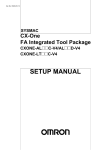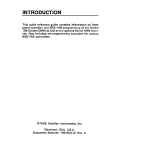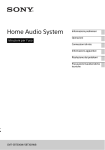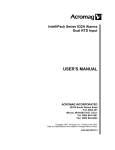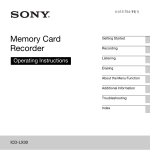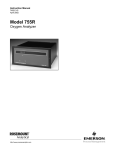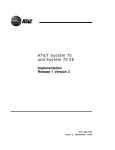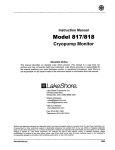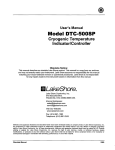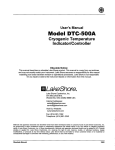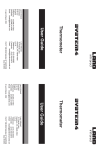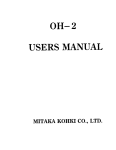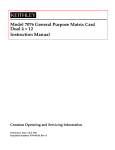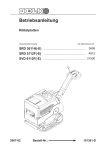Download Model DRC-80 - Lake Shore Cryotronics, Inc.
Transcript
User’s Manual Model DRC-80 Digital Cryogenic Thermometer Obsolete Notice: This manual describes an obsolete Lake Shore product. This manual is a copy from our archives and may not exactly match your instrument. Lake Shore assumes no responsibilityfor this manual matching your exact hardware revision or operational procedures. Lake Shore is not responsible for any repairs made to the instrument based on information from this manual. Lake Shore Cryotronics, Inc. 575 McCorkle Blvd. Westerville, Ohio 43082-8888USA Internet Addresses: [email protected] [email protected] Visit Our Website: www.lakeshore.com Fax: (614)891-1392 Telephone: (614)891-2243 Methods and apparatus disclosed and described herein have been developed solely on company funds of Lake Shore Cryotronics, Inc. No government or other contractual support or relationship whatsoever has existed which in any way affects or mitigates proprietary rights of Lake Shore Cryotronics, Inc. in these developments. Methods and apparatus disclosed herein may be subject to U.S. Patents existing or applied for. Lake Shore Cryotronics, Inc. reserves the right to add, improve, modify, or withdraw functions, design modifications, or products at any time without notice. Lake Shore shall not be liable for errors contained herein or for incidental or consequential damages in connection with furnishing, performance, or use of this material. Obsolete Manual July 1981 Table of Contents I. 11. General Information 1.1 Introduction 1.2 Description 1.3 Major Assemblies Supplied 1.4 Ordering of Replacement or Additional Sensors 1 Installation 2.1 Introduction 2.2 Initial Inspection 2.3 Power Requirements 2.4 Grounding Requirements 2.5 Installation 2.6 Repackaging for Shipment 4 4 4 4 4 III. Operating Instructions 3.1 Introduction 3.2 Controls, Indicators, Connectors 3.3 Temperature Readout 3.4 Analog Output of Temperature 3.4.1 Field Installation of DRC Options - 8022 and 8025 3.5 Standard DT-500DRC and DT-500CU-DRC-36 Curves 3.6 Rack Mounting the DRC-80 3.7 The 10-Sensor Selector Switch 3.8 Remove Parallel BCD Output Option 3 . 9 IEEE Interface Option 3.9.1 General IEEE Specifications & Operation 3.9.2 Specific Operation of the DRC8-IEEE Interface, Model 8024 3.9.3 Sample Programming 3.9.4 Field Installation of DRC-IEEE, Model 8024 IV. V. VI. Theory of Operation 4.1 Introduction 4.2 Detailed Description 4.2.1 Power Supplies 4.2.2 Precision Constant Current Source and Front Panel Switching 4.2.3 A/D Converter and Microprocessor System 4.2.4 Software - DRC-80 Cryogenic Thermometer 4.2.5 Digital Display Board Calibration and Troubleshooting 5.1 Introduction 5.2 Test Equipment 5.3 General Remarks 5.4 Instrument Calibration 5.4.1 Current Source 5.4.2 A/D Converter 5.4.3 Adjustment of Output Buffer 5.4.4 DRC8-L/A Option Model 8025 5.5 Instrument Tests DRC-80 Replaceable Parts List 1 2 3 5 7 7 8 13 13 13 13 13 15 18 18 19 20 21 22 22 22 23 23 24 26 27 27 27 27 27 28 28 28 28 31 ii Table of Illustrations Figure 1.1 Model DRC-80 Digital Cryogenic Thermometer Figure 2.1 Sensor, Cable, and Monitor Connections 6 Table 3.1 Entry Number Correlation 7 Figure 3.1 DRC-80 Front Panel 9 Figure 3.2 DRC-80 Rear Panel 9 Table 3.2 DT-500DRC(D curve) Voltage-Temperature Characteristic 10 Figure 3.3 Model DRC-80 shown with RM-3H Rack Mounting Hardware 14 Figure 3.4 Model DRC-80 and SW-10A shown with RM-3H Rack Mounting Hardware 14 Figure 3.5 Model DRC-80 and SW-10A Rear View showing RM-3H Rack Mounting Hardware and Umbilical Cord Connections 14 Table 3.3 SW-10A Connector Detail 16 Table 3.4 BCD Temperature Output Figure 3.6 DRC80-IEEE-488, Model 8024, Panel Layout 21 Figure 4.1 Software Flow Diagram for DRC-80 Digital Thermometer 25 Table 5.1 DRC-80 Signals Associated with Fig. 5.1 29 Figure 5.1 DRC-80 Signals 30 Figure 6.1 DRC-80 Power Supply Schematic 36 Figure 6.2 DRC-80 Main Board Schematic 37 Figure 6.3 DRC-80 Main Board Component Layout 38 Figure 6.4 DRC-80 Display Schematic 39 Figure 6.5 DRC-80 BCD-L/A, Model 8022/25, Schematic 40 Figure 6.6 DRC-80 BCD-L/A, Model 8022/25, Component Layout 41 Figure 6.7 DRC-80 IEEE-488, Model 8024, Schematic 42 Figure 6.8 DRC-80 IEEE-488, Model 8024, Component Layout 43 - Model 8022 iv 17 iii Specifications, DRC-80 Thermometer Input: Temperature Range: 1.4 t o 330K with standard DRC Sensor ( t o 380K with other Sensors). Sensor: Silicon Diode (order separately). DT-500-DRC, DT-500CU-DRC-36 or any calibrated DT-500 Series Diode. See below for proper response curve. Sensor Input: Dual-sensor input. 4-terminal input for each sensor. Selection is via front-panel pushbuttons. Sensor Excitation: 10-microampere current source. Stability ±0.005%. Sensor Response Curve: Domestic US units require Sensor Curve "D". Export units require Sensor Curve "E". Sensor curves subject to change, refer to manual for proper curve when reordering Sensors. Curves to match existing Sensors available on special request. See also DRC-Precision Option. Input Resistance: Greater than 1000 megohms. Maximum Sensor Power Dissipation: 25µW at 4.2K Temperature Readout: Display: 4-digit, 1.1cm (0.43") LED shows temperature directly in Kelvin. Resolution: 0.1 K. "Scale Expand" increases resolution to 0.01 K for temperatures below 30K. 0.05K from 30K to 100K (no increase in accuracy). Accuracy (20-25°Cambient): ±0.5K at 4K and 77K, ±1 .OK at 330K with standard Sensor. See DRC-Precision Option for accuracy with Lake Shore calibrated Sensor. Temperature Coefficient (10-20°C and 25-45° ambient): ±0.01K/°C. Response Time: Less than 1 second to rated accuracy. General: Monitor Output: Buffered output of Display Sensor voltage (additional outputs listed below as options). Dimensions, Weight: 216mm wide x 102mm high x 330mm deep (8.5 in x 4 i n x 13 in). Style L. half-rack package. Net weight 3.6 kg (7.9 Ibs). Power: 90-110, 105-125, or 210-250VAC (switch-selected), 50 or 60Hz. Accessories Supplied: Mating connectors for sensor inputs and monitor, instruction manual. FIGURE 1.1 Options and Accessories Available: Model8022. Parallel BCD output for DRC-80. TTL compatible. Provides BCD output of temperature i n Kelvin and Sensor selected (either from front-panel or optional SW-10A) . Model 8024. IEEE-488 output for DRC-80. Provides digital output of temperature in Kelvin and Sensor selected (either from front-panel or optional SW-10A). Model8025. Analog output proportional to Kelvin temperaturefor use with recordersorother readouts. 10mV/K at < 10 ohm output resistance (field installable) . Model 8022/25. Combination of 8022 (BCD output) and 8025 (Analog output) installed in same u n i t . Model SW-10A. 10-Sensor Selector Switch for use with DRC Thermometer or Controller. Push-button selection of any one of up to 10 sensors. Connects t o Sensor "B" position of instrument. Sensor selected is also identified via 8022 or 8024 digital interfaces. Dimensions: 216mm wide x 102mm high x 330mm deep (8% in x 4 in x 13 in). Style L half-rack package . Model RM-3H. Rack mounting hardware to mount either one or two Style L half-rack unit(s) in standard 3%" rack space. DRC-Precision Option: Custom-programmed read-onlymemory for DRC instruments which improves specified accuracy to 0.1 K or better over a given calibration range. Any DT-500 Series Silicon Diode Sensor can be utilized. Requires that an appropriate calibration be purchased for the Sensor. Specify Sensor input position (A o r B or 1-10 on SW-10A) to assure proper location of calibration within PROM. First calibration stored . Subsequent calibrations stored in same PROM . Model DT-500-DRC Sensor. Silicon Diode Temperature Sensor for DRC-80 (1.5mm diameter ×4.1mm long). Specify response curve . Model DT-500CU-DRC-36. Silicon Diode Temperature Sensor for DRC-80 (8mm diameter x 3.3mm thick with mounting hole). Specify response curve. Model D R C - 8 0 Digital C r y o g e n i c Thermometer iv SECTION I General Inf o rma t i on 1.1 Introduction The following is a description of the DRC-80 Cryogenic Digital Thermometer. The DRC-80 Series of instruments is designed to be used with the Model DT-500-DRC and DT-500CU-DRC-36 silicon diode sensors manufactured by Lake Shore Cryotronics, Inc. Several different diode sensor curves are available for use with this instrument. When ordering replacement sensors, care must be taken to assure that the correct sensor curve is specified. Multiple curves are needed so that Lake Shore can assure the customer that replacement sensors will be available at any time in the future. For details, please see Section 1.4. 1.2 Description The DRC-80 Series is comprised of completely self-contained units providing direct digital readout in Kelvin temperature units and, for the controllers, temperature control by direct analog comparison between the sensor voltage and an analog equivalent of the digital temperature set point. The DRC-80 displays temperature to 0.1 Kelvin over its operating range of 1-400 Kelvin for normal operation. In the scale expand mode, the resolution is 0.01 Kelvin below 30 Kelvin and 0.05 Kelvin from 30K to 100 Kelvin. The specified range of operation is 4.0 to 380K* utilizing standard DRC series sensors which have been pre-selected to provide uniform characteristics over this range. These sensors conform to the standard table (see Table 3.3) to 0.5K or better below 77K and better than 1 Kelvin above 77K. The instrument, however, displays down to 1K although accuracy is only specified above 4K. Pre-selection allows the DRC-80 Series to be used with the DT-500-DRC and DT-500CU-DRC-36 sensors without adjustments of any kind. Since the standard sensors are interchangeable, the instruments may be used to read out any number of sensors with equal accuracy when selected through an appropriate switch such as the SW-10A. The DRC-80 has dual sensor inputs. panel pushbuttons. Sensor selection is made via front- As a standard feature, all units are equipped with buffered analog output of the display sensor voltage. This allows the instrument user the ability to record the display sensor voltage versus time or to use a digital voltmeter to measure the display sensor voltage directly. Since this output ‘ i s buffered, a high input impedance recorder or voltmeter is not required. *If possible, temperatures above 330K should be avoided with DRC Series sensors since these sensors may slightly shift their values below 20K i f heated above 330K. -1- If the sensor is calibrated by the user or by Lake Shore Cryotronics, Inc., temperature may be determined to approximately 10mK. Five options are available with the DRC-80 Series of instruments. One option is an analog signal which is proportional to temperature (Model 8025) and has a sensitivity of 10 mV/K. A second option is a ten-position switch S W - 1 0 A for multiple sensor readout. This switch is a separate half-rack box which plugs into the Sensor "B" position of the DRC-80. The sensor selected is also identified via digital interface of the DRC-80, if present. Another option is a custom cut PROM (DRC-Precision Option) which corresponds to the calibration curve of the customer's DT-500 Series sensor. A combination of a calibration and custom cut PROM will increase display accuracy to better than .1 Kelvin over the calibrated range. Please note that any sensor may be used with this option, i.e., the customer is not restricted to the DRC Series sensors. There are two computer options available; each will output the displayed temperature and sensor selected from the SW-10A. The Model 8022 is in a parallel BCD format while the Model 8024 is in the popular IEEE-488 format. The DRC-80 Series is designed around an 3870 microprocessor and associated support circuits. The DRC curve is stored in a PROM which can handle up to 32 break points. The data consists of a table of temperature and voltage associated with each break point. These straight line segments can generate the DRC curve to an accuracy of better than 0.1 Kelvin over the entire temperature range (4.0 - 400 K). 1.3 Major Assemblies Supplied The DRC-80 Series includes as standard equipment, in addition to the digital thermometer-controller, the following: A. Operating and Servicing Manual B. Two five Pin Plugs for Temperature Sensor Cables C. One seven Pin Plug for Monitor of Sensor Output Voltage and the DRC8-L/A option Model DT-500 Series silicon diodes are not supplied as part of the DRC-80 instrument. Complete Specifications, Accessory Equipment and Customs Options are listed in the front of the Manual. -2- 1.4 Ordering of Replacement or Additional Sensors Two different sensor configurations are available for use with the Model DRC-80 Series instruments. These are the DT-500-DRC and the DT-500CUDRC-36 sensors. Their description is included elsewhere in this manual. All sensor configurations are available if the diode is calibrated and a special PROM is cut. More than one curve presently exists which can be used with the DRC-80 Series instruments. If additional sensors are ordered for use with your instrument, you must be certain to order the correct curve so that your instrument will have its stated accuracy. The proper curve may, be determined in one of the following ways: A . Specify the sensor serial number that is currently being used with the instrument (serial number is found on the end of the plastic box in which the sensor was received). B. Specify the serial number of your instrument. Our records will indicate with which sensor the instrument is compatible. C. Remove the top of your instrument and observe the indicator on the PROM. D. The fourth way is to measure the diode voltage at 4.2K and give this value to Lake Shore Cryotronics, Inc. when reordering sensors. -3- This Page Intentionally Left Blank SECTION II Installation 2.1 Introduction This section contains information and instructions necessary for the installation and shipping of the model DRC-80 Cryogenic Thermometer. Included are initial inspection instructions, power and grounding requirements, installation information and instructions for repackaging for shipment. 2.2 Initial Inspection This instrument was electrically and mechanically inspected prior to shipment. It should be free from mechanical damages, and in perfect working order upon receipt. To confirm this, the instrument should be inspected visually for obvious damage upon receipt and tested electrically by use to detect any concealed damage. Be sure to inventory all components supplied before discarding any shipping materials. If there is damage to the instrument in transit, be sure to file appropriate claims with the carrier, and/or insurance company. Please advise the company of such filings. In case of parts' shortages, please advise the company. The standard Lake Shore Cryotronics warranty is given on the title page. 2.3 Power Requirements Before connecting the power cable to line voltage, insure that the instrument is of the proper line voltage and fused accordingly. The line voltage and fuse are shown on the rear panel of the instrument. The line voltage can be changed by switching line voltage selector switch (S2 - Figure 6.3 DRC-80 Component Layout) located on the main printed circuit board of the unit. Nominal permissible line voltage fluctuation is ±10% at 50 to 60 Hz. 2.4 Grounding Requirements To protect operating personnel, the National Electrical Manufacturer's Association (NEMA) recommends, and some local codes require, instrument panels and cabinets to be grounded. This instrument is equipped with a threeconductor power cable which, when plugged into an appropriate receptacle, grounds the instrument. 2.5 Installation The DRC-80 Thermometer is all solid state and does not generate significant heat. It may therefore be rack mounted in close proximity to other equipment in dead air spaces. The heat from such adjacent equipment should not subject the thermometer to an ambient temperature in excess of 50°C (122°F). -4- As with any precision instrument, it should not be subjected to the shock and vibrations which usually accompany high vacuum pumping systems. The recommended cable diagrams for the sensor diodes are shown in Figure 2.1 (a). The use of a four wire diode connection is highly recommended to avoid introducing lead IR drops which will occur if the alternate two lead sensor cable connection is used. For example, for a two lead connection, every 25 ohms of cable resistance corresponds to a .1 K error above 30 Kelvin. The alternate wiring scheme shown in Figure 2.1 (b) may be used for the diode in less critical applications where lead resistance can be kept small. The indicated shielding connections are the recommended standard practice to avoid ground loops. 2.6 Repackaging for Shipment Before returning an instrument to the factory, should repair be necessary, please discuss the malfunction with a factory representative. He may be able to suggest several field tests which will preclude returning a satisfactory instrument to the factory when the malfunction is elsewhere. If it is indicated that the fault is in the instrument after these tests, the representative will provide shipping and labeling instructions for returning it. When returning an instrument, please attach a tag securely to the instrument itself (not on the shipping carton) clearly stating: A. Owner and Address B. Instrument Model and Serial Number C. Malfunction Symptoms D. Description of External Connections and Cryostats If the original carton plastic bag, place in carton controls, and close carton. mailing labels and "FRAGILE" is available, repack the instrument in a using original spacers to protect protruding Seal lid with paper or nylon tape. Affix warnings. -5- FIGURE 2.1 Sensor, C a b l e , a n d Monitor Connections -6- This Page Intentionally Left Blank SECTION III Operating Instructions 3.1 Introduction This section contains a description of the operating controls and their adjustment under normal operating conditions, and typical controller applications. These instructions are based upon the instrument having been installed as outlined in Section II. The diode polarity a s shown in Figure 2 . 1 (a), in particular, must be correct. 3.2 Controls, Indicators, Connectors The operating controls, indicators and connectors on the DRC-80 instrument's front and rear panels are shown in Figures 3 . 1 , and 3 . 2 . The numbers with leaders to various controls in the figures are keyed to the entries in Table 3 . 1 . Table 3 . 1 - Entry Number Correlation 1 POWER A.C. line switch (ON/OFF) (Display serves as indicator light). 2 Scale Expand With button out, the display reads to 0.1K at all temperatures; with button in detent position, temperature reads to 0 . 0 1 K below 30K, 0.05K between 30K and 100K, and to 0.1K above 1 0 0 K . 3 Sensor B Selects Sensor B. 4 Sensor A Selects Sensor A. 5 NO LABEL Digital temperature display located behind filter panel. Sensor displayed depends on sensor selected. 6 NO LABEL A.C. line cord 7 Fuse A.C. line fuse 8 Sensor A Sensor input lead terminals (Pin A, I+, Pin E, V+, Pin B, I-, Pin D , V-, Pin H, Shield). -7- Monitor Analog output of sensor voltage (0-2.5v, Pin A ) and optional linear analog output of temperature(0-4V, Pin C). Pin B is ground for sensor voltage while Pin D is ground for L / A output. 10 Sensor B Same as Sensor A 11 Interface BCD input of set point/output of temperature. Also I E E E interface port. 9 3.3 Temperature Readout The sensor(s) and heater should be installed following the suggestions listed in the "Installation and Application Notes for Cryogenic Sensors" brochure in Section VIII. Connect the sensor(s) to the instrument following the diagram in Figure 2 . 1 . Depress the power switch and observe that the display shows the proper temperature relative to the sample temperature. The sensor and readout display should follow the curve in Table 3 . 2 . This curve illustrates typical values expected of the DT-500-DRC or DT-500CUDRC-36 sensors. If the diode or lead wires are shorted, the display will read ----. If the diode is connected backwards, the display will read 4 2 8 . 0 for all curves. In the case of an open current or voltage lead, the display will slowly drift higher in temperature. The curves and appropriate PROM markings are given below: Curve PROM U13 0 Version 3 A Version 6 B Version 2 D Version 4 E Version 5 If the instrument or sensor does not agree with values listed in the table, within the accuracy of the system, consult sections on installation and/or section on troubleshooting to determine the cause and cure of the malfunction. -8- FIGURE 3.1 FIGURE 3 . 2 DRC-80 DRC-80 F r o n t Panel R e a rP a n e l -9- T a b l e 3.2 DT-500DRC (D) Voltage-Temperature Characteristic 30 29 1.4 1.5 1.6 1.7 1.8 2.5984 2.5958 2.5932 2.5906 2.5880 1.9 2.0 2.2 2.4 2.6 2.5854 2.5828 2.5735 2.5643 2.5551 2.8 3.2 3.4 3.6 2.5458 2.5366 2.5226 2.5086 2.4946 3.8 4.0 4.2 4.4 4.6 2.4807 2.4667 2.4527 2.4387 2.4247 4.8 5.5 6.0 6.5 2.4108 2.3968 2.3618 2.3269 2.2919 7.0 7.5 8.0 8.5 9.0 2.2570 2.2220 2.1871 2.1521 2.1172 9.5 12.0 13.0 2.0909 2.0646 2.0119 1.9592 1.9066 14.0 15.0 16.0 17.0 18.0 1.8338 1.7610 1.6984 1.6359 1.5646 3.0 5.0 28 10.0 11.0 27 26 25 -10- DT-500DRC (D) Voltage-Temperature Characteristic 23 19.0 20.0 21.0 22.0 23.0 1.4932 1.4219 1.3505 1.3006 1.2507 22 21 20 19 24.0 25.0 26.0 27.0 28.0 1.2114 1.1720 1.1486 1.1308 1.1190 29.0 30.0 32.0 34.0 36.0 1.1116 1.1058 1.0970 1.0902 1.0850 38.0 40.0 45.0 50.0 55.0 1.0798 1.0746 1.0633 1.0520 1.0407 12 60.0 65.0 70.0 75.0 80.0 1.0287 1.0166 1.0046 .99172 .97890 11 85.0 90.0 95.0 .96609 .95327 .93987 .92647 .91307 24 18 17 16 15 14 13 100.0 105.0 110.0 10 115.0 120.0 125.0 130.0 .89966 .88626 .87286 .85946 .84606 135.0 140.0 145.0 150.0 155.0 .83228 .81850 .80472 .79094 .77716 -11- DT-500DRC (D) Voltage-Temperature Characteristic 9 8 7 6 5 4 3 2 1 160.0 165.0 170.0 175.0 180.0 .76338 .74961 .73582 .72170 .70757 185.0 190.0 195.0 200.0 205.0 .69344 ,67931 .66518 .65105 .63693 210.0 215.0 220.0 225.0 230.0 .62280 .60867 .59455 .58080 .56707 235.0 240.0 245.0 250.0 255.0 .55334 .53960 .52649 .51337 .50026 260.0 265.0 270.0 275.0 280.0 .48714 .47403 .46057 .44711 .43365 285.0 290.0 295.0 300.0 305.0 .42019 .40613 .39208 .37802 .36397 310.0 315.0 320.'0 325.0 330.0 .34940 .33482 .32025 .30568 .29111 335.0 340.0 345.0 350.0 355.0 .27654 ,26197 .24739 .23325 .21911 360.0 365.0 370.0 375.0 380.0 .20497 .19083 .17774 .16464 .15155 -12- Table 3.2 DT-500DRC (El) Voltage-Temperature Characteristic 1.4 1.5 1.6 1.7 1.8 2.6591 2.6567 2.6542 2.6518 2.6494 1.9 2.0 2.2 2.4 2.6 2.6470 2.64k6 2.6355 2.6265 2.6175 2.8 3.0 3.2 3.4 3.6 2.6084 2.5994 2.5868 2.5742 2.5616 3.8 4.0 4.2 4.4 4.6 2.5490 2.5364 2.5221 2.5077 2.4934 4.8 5.0 5.5 6.0 6.5 2.4791 2.4648 2.4290 2.3932 2.3574 26 7.0 7.5 8.0 8.5 9.0 2.3216 2.2858 2.2500 2.2142 2.1784 25 9.5 10.0 11.0 12.0 13.0 2.1516 2.1247 2.0708 2.0170 1.9632 24 14.0 15.0 16.0 17.0 18.0 1.9011 1.8390 1.7769 1.7148 1.6527 30 29 28 27 -10- DT-500DRC ( E l ) Voltage-Temperature Characteristic 23 19.0 20.0 21.0 22.0 23.0 1.5724 1.4922 1.4120 1.3317 1.2831 22 21 20 19 18 24.0 25.0 26.0 21.0 28.0 17 16 15 14 13 29.0 30.0 32.0 34.0 36.0 1.1150 1.1080 1.0981 1.0909 1.0848 38.0 40.0 45.0 50.0 55.0 1.0797 1.0746 1.0630 1.0515 1.0399 60.0 65.0 70.0 75.0 77.35 80.0 1.0284 1.0159 1.0035 0.9911 0.9849 0.9780 12 11 10 9 8 1.2357 1.1877 1.1559 1.1365 1.1239 85.0 90.0 95.0 100.0 105.0 0.9649 0.9518 0.9388 0.9257 0.9122 110.0 115.0 120.0 125.0 130.0 0.8988 0.8853 0.8718 0.8584 0.8449 135.0 140.0 145.0 150.0 155.0 0.8311 0.8173 0.8035 0.7896 0.7758 -11- DT-500DRC (El) Voltage-Temperature Characteristic 160.0 165.0 170.0 175.0 180.0 0.7620 0.7482 0.7344 0.7202 0.7060 185.0 190.0 195.0 200.0 205.0 0.6918 0.6777 0.6635 0.6493 0.6351 210.0 215.0 220.0 225.0 230.0 0.6210 0.6068 0.5926 0.5789 0.5651 235.0 240.0 245.0 250.0 255.0 0.5514 0.5377 0.5246 0.5115 0.4984 260.0 265.0 270.0 275.0 280.0 0.4853 0.4722 0.4588 0.4454 0.4320 2 285.0 290.0 295.0 300.0 305.0 0.4186 0.4045 0.3904 0.3763 0.3622 1 310.0 315.0 320.0 325.0 330.0 0.3476 0.3330 0.3184 0.3038 0.2893 7 6 5 4 3 -12- 3.4 Analog Output of Temperature The analog output of temperature takes the display temperature and converts it to an analog signal which has a sensitivity o f 10 mV/K under normal operation. Under scale expand, this signal increases to 100 mV/K below 100K due to the movement of the decimal point. The analog output voltage is located on the monitor connector (Key 9 of Figure 3.2). 3.4.1 Field Installation of DRC Options - 8022 and 8025 The installation of either the Model 8022 option (Parallel BCD) or 8025 (10 mV/K) can be done as follows: 1) Remove instrument cover. 2) Insert the model 8022125 option board into instrument JE connector (the instrument has its edge card connector configured such that the option board can only be inserted in one way). 3) Take 50 pin ribbon connector, with mounting plate attached, and place it in Interface opening, 54 (after any existing plate is removed). Note: Ribbon cable is only present for Model 8022 option. 4) Connect black (or green) and white wires of option board to 7 pin rear panel connector 53. White goes to pin C and black (or green) goes to pin D. 5) Replace instrument cover. 3.5 Standard DT-500DRC-and DT-500CU-DRC-36 Curves The standard DT-500-DRC and DT-500CU-DRC-36 curve is explained in Section 3.3. The Tables include a list of PROM sensor voltages and breakpoints used in the linearization of the DRC curve to arrive at the correct temperature readout. 3.6 Rack Mounting the DRC-80 The DRC-80 cryogenic thermometer can be rack mounted with the RM-3H rack mounting hardware as shown in Figure 3.3. This hardware kit also allows the mounting of two style L half-rack units as shown in Figures 3.4 and 3.5. 3.7 The 10-Sensor Selector Switch The 10-Sensor Selector Switch includes an umbilical which ties to the DRC-80 main printed circuit board (via a 16-pin ribbon cable header which plugs into internal socket JC (see Figure 6.3, DRC-80 Component -13- FIGURE 3.3 FIGURE 3.4 FIGURE 3.5 Model DRC-80 shown with RM-3H Rack Mounting Hardware. Model DRC-80 and SW-10A shown with RM-3H Rack Mounting Hardware. Model DRC-80 and SW-10A Rear View showing RM-3H Rack Mounting Hardware and Umbilical Cord Connections. -14- Layout) and a cable to connect the selected sensor leads to the DRC-80 (Sensor plug B is Key 10 of Figure 3.2). The SW-10A is supplied with an 18" cable which is shielded and has male 5-pin amphenol connectors at each end (see Figure 3.5, SW-10A Option). This cable connects between J11 of the SW-10A and the B sensor plug of the DRC-80. Sensors are connected to the SW-10A via printed circuit edge J10. A 36-pin edge card connector and hood has been supplied with the SW-10A Connectors to this edge J10 are given in Table 3.3. The hood mechanical assembly is given in Figure 6.9, SW-10A Hood Assembly. Provisions have been made in the DRC-80 for setting the switch position which the instrument will see (S6). Since the software of the DRC-80 allows for calibrated curves to be programmed into the 10 positions of the SW-10A a specific curve (or position) can be called up through the use of S6. BO (LSB) of S6 is actually four switches ( 4 position dip switch). switch position is between pins 1 and 8 and B 3 (MSB) is between pins 4 and 5. As an example, if the customer had precision options in positions 1 , 2 and 3 of the DRC-80 and wanted to use dip switches to call up the curves (instead of the SW-10A umbilical), he could insert a four station dip switch and turn on or off the desired position. Switch S6 should not be used in conjunction with 16 pin header JC of the SW-10A The location for S6 is an 8 pin socket placed near J C (see Fig. 6.3 , DRC-80 Component Layout). 3.8 Remote Parallel BCD Output Option The BCD option consists of a 16 bit parallel output of temperature along with a scale expand bit to indicate decimal point, and a 4 bit output of switch position from the SW-10A Table 3.4 can be used for output line coding. The BCD out is handled through connector 54 (denoted on back panel as INTERFACE), a 50 pin connector on the rear panel of the instrument. Data latches internal to the instrument provide a 1-2-4-8 code using positive logic with standard TTL levels of 0.4 volts or less for low (logic 0) and 2.4 volts or higher for the high (or 1) state under full load conditions. The drivers are sufficient to drive two standard loads, 3.2 mA, in the low state. The sensor temperature output is externally gated through the use of an internally generated data valid pulse. -15- Table 3.3 SW-10A CONNECTOR DETAIL Function Shield IV+ V- I+ V+ VI+ V+ VI+ V+ VI+ V+ V- I+ V+ V- I+ V+ VI+ V+ VI+ V+ VI+ V+ VI+ Sensor Edge Connector C o n t a c t A11 A11 1 A 1 1 3 2 2 2 3 3 3 4 4 4 5 5 5 6 6 6 7 7 7 8 8 8 9 9 9 10 10 10 1 2 B C D 4 E F 5 H J 6 K L 7 M N 8 P R 9 S T 10 U V 11 17 18 12 -16- Table 3 . 4 BCD TEMPERATURE OUTPUT - MODEL DRC-SERIES REMOTE OUTPUT BCD TEMPERATURE OUTPUT BCD TEMPERATURE OUTPUT 1 800180 2 33 Data V a l i d 34 Ground 3 400/40 4 35 36 SW-B2 5 2001 2 0 6 37 Trend B i t 1 - .01 0 - .1 SW-B3 7 100110 8 39 Not used 40 9 8018 10 11 4014 12 13 201 2 14 15 101 1 16 17 81.8 18 19 41.4 20 21 21.2 22 23 11.1 24 25 . 8 / . 08 26 27 .4/. 04 28 29 . 2 / . 02 30 SW-B0 31 .1/.01 32 SW-B1 38 41 42 43 44 45 46 47 48 49 Not used 50 + 5V Not used -17- 3.9 IEEE Interface Option The IEEE interface option available for the DRC-80 fully complies with the IEEE standard 488-1978 and incorporates the functional, electrical and mechanical specifications of the standard. 3.9.1 General IEEE Specifications and Operation The following discussion covers the general operation of the IEEE-488 interface. For a more detailed description of signal level and interaction, refer to the IEEE Std. 488-1978 publication "IEEE Standard Digital Interface for Programmable Instrumentation". All instruments on the interface bus must be able to perform the interface functions of TALKER, LISTENER, or CONTROLLER. A TALKER transmits data onto the bus to other devices. A LISTENER receives data from other devices through the bus. Some devices perform both functions. The CONTROLLER- designates to the devices on the bus which function to perform. The IEEE works on a party line basis with all devices on the bus connected in parallel. ALL the active circuitry of the bus is contained within the individual devices with the cable connecting all the devices in parallel to allow the transfer of data between all devices on the bus. There are 16 signal lines contained on the bus and consist of: A) 8 Data Lines B) 3 Byte Transfer Control Lines C) 5 General Interface Management Lines The data lines consist of 8 signal lines that carry data in a bit parallel, byte serial format. These lines carry universal commands, addresses, program data, measurement data, and status to all the devices on the bus. The controller designates the functions of the units on the bus by setting the ATN line low (true) and sending talk or listen addresses on the DATA lines. When the ATN line is low, all devices listen to the DATA lines. When the ATN line goes high (false), then the devices addressed to send or receive data perform their functions while all others ignore the DATA lines. Transfer of the information on the data lines is accomplished through the use of three signal lines: DAV (Data Valid), NRFD (Not Ready For Data), and NDAC (Not Data Accepted). These signals operate in an interlocking handshake mode. The two signal lines, NRFD, and NDAC are each connected in a logical AND to all devices connected to the bus. The DAV is sent by the talker and received by listeners while the NRFD and NDAC are sent by listeners back to the talker. The General Interface Management Lines manage the bus and control the orderly flow of commands on the bus. The IFC (Interface Clear) message -18- b a s i c a l l y clears t h e i n t e r f a c e t o a known s t a t e a p p r o p r i a t e t o t h e d e v i c e b e i n g a d d r e s s e d . SRQ ( S e r v i c e Request) i s used by a d e v i c e t o i n d i c a t e t h e need f o r a t t e n t i o n o r s e r v i c e and t o r e q u e s t an i n t e r r u p t i o n of d a t a flow. REN (Remote Enable) i s used t o s e l e c t between two s o u r c e s of d e v i c e d a t a ( a s a n example: f r o n t p a n e l o r rear p a n e l c o n t r o l s on a measurement d e v i c e ) . EOI (End or I d e n t i f y ) i n d i c a t e s t h e end of a m u l t i p l e b y t e t r a n s f e r sequence, o r a l o n g w i t h t h e ATN l i n e , e x e c u t e s a p o l l i n g sequence. The f o l l o w i n g t a b l e shows c a b l e c o n n e c t o r c o n t a c t w i r i n g f o r t h e IEEE488 bus : Contact 1 2 3 4 5 6 7 8 9 10 11 12 Note: 3.9.2 Signal Line D101 DI02 DI03 DI04 EOI (24) DAV NRFD NDAC IFC SRQ ATN SHIELD Contact 13 14 15 16 17 18 19 20 21 22 23 24 Signal Line DI05 DI06 DI07 DI08 REN ( 2 4 ) Gnd (6) Gnd ( 7 ) Gnd (8 ) Gnd ( 9 ) Gnd (10) Gnd (11) Gnd (LOGIC) Gnd(n) r e f e r s t o t h e s i g n a l ground r e t u r n of t h e r e f e r e n c e d c o n t a c t . EOI and REN r e t u r n on cont a c t 24. S p e c i f i c O p e r a t i o n of t h e DRC8-IEEE I n t e r f a c e , Model 8024 The DRC-8-IEEE Model 8024 p r o v i d e s a d i g i t a l o u t p u t of t e m p e r a t u r e i n K e l v i n , a s w e l l a s t h e s t a t u s of t h e f r o n t p a n e l s w i t c h e s and SW-10 s w i t c h p o s i t ion. Address and f u n c t i o n s e l e c t i o n are made v i a a s w i t c h package l o c a t e d on t h e rear p a n e l of t h e DRC-80 ( s e e F i g u r e 3.6, DRC-IEEE P a n e l L a y o u t ) . P o s i t i o n s 4-8 of t h e s w i t c h a r e t h e a d d r e s s s w i t c h e s f o r t h e i n t e r f a c e w i t h 4 b e i n g t h e most s i g n i f i c a n t b i t and 8 b e i n g t h e l e a s t s i g n i f i c a n t b i t . A s a n example: w i t h s w i t c h e s 5 , 6 , and 7 ON ( o r down), and s w i t c h e s 4 and 8 OFF ( o r u p ) , t h e a d d r e s s s e l e c t e d i s 1 4 ( o r E b a s e 1 6 ) . The DRC-80 I E E E I n t e r f a c e i s a t a l k e r o n l y . The t a l k mode c a n b e d e - s e l e c t e d by t u r n i n g s w i t c h 3 ON ( o r down). Switch p o s i t i o n 1 i s used t o s e l e c t t h e o r d e r in which t h e o u t p u t d e l i m i t e r s are p u t o n t o t h e IEEE b u s . The f o l l o w i n g t a b l e g i v e s t h e d e l i m i t e r o r i e n t a t i o n versus switch position: -19- Switch 1 P o s i t i o n D e l i m i t e r Order (Delm 1)(Delm 2 ) Up (OFF) Down (ON) (LF) (CR) (CR) (LF) The u s e of t h i s s w i t c h a l l o w s t h e DRC8-IEEE t o i n t e r f a c e t o c o n t r o l l e r s which a c c e p t b o t h forms of d e l i m i t e r s t o t e r m i n a t e i n p u t s t r i n g s . NOTE: t h e a d d r e s s s w i t c h e s a r e updated on power up o n l y . The a d d r e s s and del i m i t e r o r i e n t a t i o n i s r e a d o n l y when t h e i n s t r u m e n t i s t u r n e d on. Any change i n t h e a d d r e s s s w i t c h w h i l e t h e i n s t r u m e n t i s on w i l l b e i g n o r e d . The The DRC8-IEEE t r a n s m i t s and r e c e i v e s a l l c h a r a c t e r s i n ASCII. c a b l e c o n n e c t o r meets IEEE-488, 1978 s t a n d a r d s and i s p o l a r i z e d f o r p r o p e r cable insertion. I n t h e t a l k e r mode t h e i n t e r f a c e o u t p u t s s w i t c h s e t t i n g s , f r o n t p a n e l s e t t i n g s , and d i s p l a y t e m p e r a t u r e . The d a t a i s o u t p u t i n t h e form of two s t r i n g v a r i a b l e s . A f t e r e a c h of t h e v a r i a b l e s i s o u t p u t , d e l i m i t e r s DELM 1 and DELM 2 a r e t r a n s m i t t e d . A f t e r t h e second v a r i a b l e , t h e l a s t d e l i m i t e r h a s t h e EO1 l i n e s e t f o r end of t r a n s m i s s i o n . NOTE: I n programming f o r a n i n p u t from t h e DRC8-IEEE i n t e r f a c e two s t r i n g v a r i a b l e s must b e used ( o r r e a d i n t o t h e computer) o r t h e i n t e r In outputting data f a c e w i l l hang up, w a i t i n g t o o u t p u t a l l of t h e d a t a . t o an a r r a y , t h e a r r a y must have enough e l e m e n t s t o a l l o w t h e i n p u t of b o t h v a r i a b l e s from t h e DRC8-IEEE i n t e r f a c e ( i n t h i s c a s e t h e number of elements i s 13). S i n c e t h e r e are two sets of d e l i m i t e r s o u t p u t , and most computers u s e t h e s e d e l i m i t e r s t o t e r m i n a t e s t r i n g v a r i a b l e s , t h e need f o r two s t r i n g v a r i a b l e s arises. An example of a t r a n s m i s s i o n i s a s f o l l o w s : Format f o r Data Format L i m i t s ( X ) Front Panel XX(DELM1) (DELM2) 0-9, Temperature XXXX.XX (DELM1) (DELM2) numberics o n l y Function A-F The two f r o n t p a n e l c h a r a c t e r s a r e o u t p u t i n a packed f o r m a t w i t h The f r o n t p a n e l i n d i c a t o r s i n d i v i d u a l b i t s r e p r e s e n t i n g a p i e c e of d a t a . are d e n o t e d a s f o l l o w s : -20- Bit a) B i t s 1-4 SW-10 A D i s p l a y Sensor s w i t c h s e t t i n g s w i t h b i t 1 b e i n g t h e Least S i g n i f i c a n t B i t and b i t 4 b e i n g t h e Most S i g n i f i c a n t B i t . b) Bit 5 N /A c) Bit 6 N /A d) Bit 7 D i s p l a y Sensor e) Bit 8 NOTE: S c a l e EXPAND Mode 0 A 1 B 0 Button Out (Normal) 1 Button I n (Expanded S c a l e ) * The expanded scale b i t i s s e t o n l y i f t h e b u t t o n i s i n and t h e d i s p l a y t e m p e r a t u r e i s below 1 0 0 . 0 ° K . A c h a r t which shows t h e p u s h b u t t o n i n f o r m a t i o n and c o r r e s p o n d i n g o u t p u t c h a r a c t e r i s shown below. ( T h i s i s d a t a r e p r e s e n t e d by t h e f i r s t c h a r a c t e r of t h e P a n e l i n f o r m a t i o n v a r i a b l e , o r b i t s 5-8 above.) output Character Bit Representation Expanded Scale Display Sensor 0 0000 NO A 4 0100 NO B 8 1000 YES A C 1100 YES B The SW-10A s w i t c h p o s i t i o n i s r e p r e s e n t e d by t h e c h a r a c t e r s 1-9, and A. The 1-9 s t a n d s f o r p o s i t i o n s 1 t h r u 9, t h e A s t a n d s f o r p o s i t i o n 10. The s w i t c h p o s i t i o n i n f o r m a t i o n i s o n l y p r e s e n t f o r t h e B d i s p l a y s e n s o r . When t h e A p o s i t i o n i s s e l e c t e d as d i s p l a y s e n s o r , t h e p o s i t i o n i s r e t u r n e d as zero. (When t h e r e i s no p o s i t i o n p r e s e n t f o r t h e B d i s p l a y s e n s o r , t h e s w i t c h p o s i t i o n i s r e t u r n e d as z e r o . ) An example of t h e p a n e l i n f o r m a t i o n f o r a DRC i n s t r u m e n t t h a t i s i n t h e expanded scale mode, h a s B as d i s p l a y s e n s o r , and h a s an SW-10A p o s i t i o n of 2 would look l i k e : C2. switch A n example f o r a t r a n s m i s s i o n f o r a n i n s t r u m e n t which h a s : 1 of t h e IEEE a d d r e s s s w i t c h up a t power on, s c a l e expand b u t t o n i n , A a s d i s p l a y s e n s o r , no SW-10A i n p u t , and a d i s p l a y of 24.06°K would l o o k l i k e : 80(LF) (CR)0024.06(LF) (CR) EOI SET ON FINAL (CR) -21- 3.9.3. Sample Programming T h i s s e c t i o n c o n t a i n s some sample programming f o r t h e DRC8-IEEE o p tion. Commodore Pet/CBM 2001 3.9.3.1 S e t t h e a d d r e s s s w i t c h t o 6 by p u t t i n g a d d r e s s s w i t c h e s 6 and 7 down; 8, 5 and 4 up. Make s u r e s w i t c h 3 i s up ( o f f ) t o a l l o w t h e DRC8-IEEE t o talk. S e t s w i t c h 1 up ( o f f ) t o s e l e c t (LF)(CR) as t h e d e l i m i t e r o r i e n t a t i o n . NOTE: The a d d r e s s s w i t c h i s updated o n l y on power up. Conn e c t t h e CBM I E E E c a b l e t o t h e DRC8-IEEE i n t e r f a c e . Turn on t h e PET and e n t e r t h e program below, i n c l u d i n g l i n e numbers, by p r e s s i n g t h e RETURN k e y a f t e r e v e r y l i n e . A f t e r e n t e r i n g t h e program, t y p e RUN and p r e s s t h e RETURN key. The d i s p l a y w i l l t h e n r e t u r n t h e d a t a from t h e i n s t r u m e n t . 10 20 30 40 50 60 PRINT"PANEL ";P$ PR1NT"TEMPERATURE"; T$ END 70 80 3.9.3.2 OPEN2.6 INPUT#2, P$, T$ CLOSE2 PRINT PRINT HP-85 S e t t h e a d d r e s s s w i t c h t o 6 by p u t t i n g a d d r e s s s w i t c h e s 6 and 7 down; 8 , 5 and 4 up. Make s u r e s w i t c h 3 i s up ( o f f ) t o a l l o w t h e DRC8-IEEE t o talk. S e t s w i t c h 1 down (on) t o s e l e c t (CR)(LF) a s t h e d e l i m i t e r o r i e n t a t i o n . NOTE: The a d d r e s s s w i t c h i s u p d a t e d o n l y on power up. Connect Turn on t h e u n i t and t h e DRC8-IEEE t o t h e I E E E i n t e r f a c e of t h e HP-85. e n t e r t h e program below, i n c l u d i n g l i n e numbers, by p r e s s i n g t h e END L I N E key a f t e r e v e r y l i n e . P r e s s t h e RUN key. The d i s p l a y w i l l t h e n r e t u r n t h e d a t a from t h e i n s t r u m e n t . 10 20 30 40 50 60 3.9.3.3 ENTER706;P$,T$ PRINT PRINT PRINT"PANEL ";P$ PRINT"TEMPERATURE" ;T$ END HP-9845B S e t t h e a d d r e s s s w i t c h t o 6 by p u t t i n g a d d r e s s s w i t c h e s 6 and 7 down; 8 , 5 and 4 up. Make s u r e s w i t c h 3 i s up ( o f f ) t o a l l o w t h e DRC8-IEEE t o talk. S e t s w i t c h 1 down (on) t o s e l e c t (CR)(LF) as t h e d e l i m i t e r o r i e n t a t i o n . NOTE: The a d d r e s s s w i t c h i s u p d a t e d o n l y on power up. Connect t h e DRC8-IEEE t o t h e 98034A I E E E i n t e r f a c e of t h e 9845B. Turn on t h e u n i t and e n t e r t h e program below, i n c l u d i n g l i n e numbers, by p r e s s i n g t h e STORE -21A- key a f t e r e a c h l i n e i s e n t e r e d . P r e s s t h e RUN key. t h e n r e t u r n t h e d a t a from t h e i n s t r u m e n t . 10 20 30 40 50 60 70 3.9.3.4 DIMP$[5],T$[10] ENTER706;P$ ,T$ PRINT PRINT PRINT"PANEL " The d i s p l a y w i l l ;P$ PRINT"TEMPERATURE";T$ END HP-9825A S e t t h e a d d r e s s s w i t c h t o 6 by p u t t i n g a d d r e s s s w i t c h e s 6 and 7 down; 8 , 5 and 4 up. Make s u r e s w i t c h 3 i s up ( o f f ) t o a l l o w t h e DRC8IEEE t o t a l k . S e t s w i t c h 1 down (on) t o s e l e c t (CR)(LF) as t h e d e l i m i t e r orientation. NOTE: The a d d r e s s s w i t c h i s updated o n l y on power up. Connect t h e DRC8-IEEE t o t h e 980348 IEEE i n t e r f a c e of t h e 98258. Turn on t h e u n i t and e n t e r t h e program below by p r e s s i n g t h e STORE key a f t e r The p r i n t e r w i l l r e a d t h e d a t a e a c h l i n e i s typed. P r e s s t h e RUN key. from t h e i n s t r u m e n t . 0 dim P $ [ 5 ] , T $ [ 1 0 ] 1 r e d 706,P$,T$ 2 3 4 3.9.3.5 p r t P$ p r t T$ end HP-9835A S e t t h e a d d r e s s s w i t c h t o 6 by p u t t i n g a d d r e s s s w i t c h e s 6 and 7 down; 8, 5 and 4 up. Make s u r e s w i t c h 3 i s up ( o f f ) t o a l l o w t h e DRC8IEEE t o t a l k . S e t s w i t c h 1 down (on) t o s e l e c t (CR)(LF) as t h e d e l i m i t e r o r i e n t a t i o n . NOTE: The a d d r e s s s w i t c h i s updated o n l y on power up. Connect t h e DRC8-IEEE t o t h e 980348 i n t e r f a c e of t h e HP-35A. Turn on t h e u n i t and e n t e r t h e program below by p r e s s i n g t h e STORE key a f t e r e a c h l i n e i s typed. P r e s s t h e RUN key. The d i s p l a y w i l l r e t u r n t h e d a t a from t h e instrument. 10 20 30 ENTER706;P$,T$ PRINT PRINT 40 PRINT"PANEL ";P$ PR1NT"TEMPERATURE"; T$ END 50 60 -21B- 3.9.4 F i e l d I n s t a l l a t i o n of DRC-IEEE, Model 8024 The DRC8-IEEE Model 8024 is e a s i l y f i e l d i n s t a l l e d as f o l l o w s : 1) Remove i n s t r u m e n t c o v e r . 2) Remove b l a n k p l a t e from I n t e r f a c e opening, 54. 3) P l u g 24 p i n u m b i l i c a l i n t o DRC-80 board c o n n e c t o r J D ( s e e F i g . 6 . 3 , DRC-80 Component Layout). 4) Place Model 8024 board i n t h e u n i t and i n s t a l l w i t h screws. (Component s i d e up). 5) Replace i n s t r u m e n t c o v e r . Cable Connect ion 1 Select switch F i g u r e 3.6 DRC80-IEEE Panel Layout -21C- This Page Intentionally Left Blank SECTION IV Theory of Operation 4.1 Introduction The Lake Shore DRC-80 is the ideal Cryogenic Thermometer for lab or system use. Its features, options, and accessories enable it to handle routine measurements or complex multi-point monitoring assignments with equal ease. Its wide measurement range covers the spectrum of most cryogenic temperature needs. The dual-sensor input enables two sensors to be used concurrently, either for verification or for monitoring temperature at different points. This multi-input capability can be further expanded with the Model SW-10A, 10-position Selector Switch which conveniently mounts side-by-side with the 80 in a standard 3½'' rack opening. Sensor selection is via front-panel pushbuttons. The display sensor voltage is fed to an Analog-to-Digital converter pair (A/D), where it is converted to a digital voltage signal proportional to the sensor voltage. The multiplexed BCD outputs from the A / D are sampled and verified by the microprocessor. The microprocessor executes a program which takes the sampled sensor voltage and, using break point voltage and temperature information stored in a tabulor array, calculates the associated Kelvin temperature to better than 0.01 Kelvin. The microprocessor then outputs the temperature information to the display board. The decoder/driver decodes this temperature data, latches the information and drives the display digits. The sensor display voltage is also available as a buffered output through the monitor plug on the rear of the instrument. The microprocessor also controls the BCD and IEEE options. 4.2 Detailed Description A detailed description of the operation of the DRC instrument is outlined in the following sections. The Figures required for each section will be denoted in that discussion. 4.2.1 Power Supplies Please refer to Figure 6 . 1 (Schematic #1) for the following discussion. There are four different power supplies incorporated in the DRC-80 instrument. The main power transformer, TX1, has split primaries for 115 or 230 volt AC operation. The slide switch, S 2 , selects the proper line voltage. -22- The first secondary is output through leads 1 and 3. This secondary is rectified by CR1 and a floating 15 volt supply is obtained through C1, C5, and the positive 15 volt regulator U1. This supply is used to power the constant current source for the diode. The second secondary, through leads 2, 4, and 6, is a full wave bridge rectified by CR2-5. A +15 volt supply is generated by C2, C6 and a positive 15 volt regulator U2. The negative 15 volt supply is generated by C3, C7 and voltage regulator U3. Both these supplies are used in the A/D converter, the buffer section, and the L/A option. The third secondary is through leads 8, 10, and 12 and is full wave rectified by CR6-7. The five volt supply that is used by the TTL IC's is formed by C4, C8, and a 5 volt positive voltage regulator U4. 4.2.2 Precision Constant Current Source and Front Panel Switching A 10µA floating constant current source is used to excite either Sensor A or B depending on the switch position chosen by the front panel switches, S5 (Sensor A) or S 4 (Sensor B). A precision reference voltage is generated by an internally stabilized precision voltage reference (U5) and resistor R1 which determines the bias current for the zener reference. Resistor R6 has a nominal 499K value so that when the voltage picked off the stable reference is close to 4.99V, the output current determined by the operational amplifier (U6) and the output FET(U7) will be exactly 10pA with a compliance voltage greater than 10V. The 10µA current is directed to Sensor A or Sensor B by the switch S5. Switch S 4 directs the positive sensor voltage of Sensor A or B to the A/D converter pair. Note that both the Sensor A and Sensor B low voltage terminals are tied together to analog ground. Therefore, the I- return of the current source will be slightly below ground (by a few millivolts, depending on lead resistance). Since S5 and S 4 are interlocking switches, the switch S 4 is used to tell the microprocessor which sensor has been selected. This information is important to the microprocessor only if a calibrated sensor is present or if a SW-10A tenposition switch option is present in Sensor position B. Switch S3 indicates to the microprocessor whether or not scale expand below 100K is desired. Switch S1 is the ON-OFF switch. display board. Power ON is indicated by a lighted 4.2.3 A/D Converter and Microprocessor System The analog-to-digital convertor consists of a high input impedance precision 4% digit I.C. pair (8052A/7103A, U12 and U10) that produces a BCD output that is accurate to ±1 count over its entire 40,000 count -23- range. The 7103A (U10) runs on a 50K Hz clock cycle generated by a 7555 clock (U11) and its associated components (R11, R12, and C11). This clock frequency allows for one reading every 0.8 seconds. The digital output signal is in a bit-parallel, byte serial form. The A/D converter output is multiplexed by U14 and U15 and input to the microprocessor. In addition to the A/D voltage information, the microprocessor inputs the sensor-selected, scale expand switch position, and in the case of the SW-10A, the position selected. The microprocessor outputs temperature information in BCD form to the display as well as to the options (BCD or IEEE), if present. If a ten-position switch is also present, the sensor position selected is also output to the option (BCD or IEEE). The microprocessor system used in the DRC-80 is a 38P70 which utilizes a piggy-back memory architecture. A 3870µp was originally a mask-memory part with the user tied to one program form when the part was fabricated. The piggy-back variation of the part allows for variable memory space (between 8K and 64K of PROM) to be placed on the top of the µp. This allows all lines that were used for addresses and data to be used for Input/Output. The microprocessor unit (MPU) has an internal RAM scratchpad memory used for programming. The unit uses an internally generated clock which is derived from the resistor fro R21 (and C21 if needed). The MPU has 4 8-bit bi-directional ports used for communication to and from the processor. Two of these ports, Port 0 and 5, are used for internal control of the instrument (A/D input, BCD temperature output to BCD L/A option and display, and internal housekeeping). The remaining two ports, Port 1 and 4, are used for option access (IEEE-488). 4.2.4 Software - DRC-80 Cryogenic Thermometer Figure 4.1 is a flow chart of the major steps in the cryogenic thermometer program. When the instrument is turned on, the program does a power ON reset and starts the software program at the beginning. At this point, the program initializes internal registers to be used in the program. The program first checks for an A/D converter overrange and then inputs multiplexed A/D information. When the A/D tells it there is fresh data ready, (the program loops until the A/D information is ready), the program then verifies that no illegal characters are present and stores the reading. The program then inputs display sensor information. There is one standard curve for the instrument and there are a maximum of twelve additional curves. There can be a calibrated curve for Sensor A , B, and ten different switch positions generated by the SW-10A. The program, through the use of some internal identifiers, determines the proper curve to be used. Once the curve is determined, the proper Voltage-Temperature Break -24- FIGURE 4 . 1 Software Flow Diagram f o r DRC-80 D i g i t a l Thermometer -25- Point is determined. The program finds the correct break point for temperature determination by checking each breakpoint voltage to see if it is lower than the input voltage. As the break point is found, the temperature is calculated using the following equation: T = (VBp - VAD) * dT + TBP dV where : T VBP is temperature in K is break point voltage VAD is input voltage dT(SBp) dV is slope between successive break points TBP is break point temperature After the correct temperature has been calculated, the program looks to see if the instrument is in the scale expand mode. In this mode, the front panel display converts to a resolution of .01K below 30K and 0.05K between 30K and 100K. The temperature data is output in a bit-parallel, digit-serial form and is latched into the display board. 4.2.5 Digital Display Board The display board receives its data in a bit-parallel/digit-serial form. The information is latched into the display decoder/driver, U101, which drives the display digits DS1-4. Control of the decimal point is carried out by the BCD/decimal decoder/driver, U102. This driver receives its information directly from the microprocessor. -26- This Page Intentionally Left Blank SECTION V Calibration and Troubleshooting 5.1 Introduction This section contains the instructions for calibrating and troubleshooting the DRC-80 instrument. 5.2 Test Equipment A high input impedance digital voltmeter and oscilloscope, and a precision resistor connected to simulate the diode wired according to Figure 2.1 (b) are normally sufficient to test and calibrate the DRC-80 instrument. 5.3 General Remarks On installation, one of the major problems is an improperly connected temperature sensing diode. It is advised that other portions of the cryogenic system be tested before the instrument is troubleshooted. Some checks that could be made are: 1) Open or shorted sensor leads (especially in an area of frequent disassembly). 2) Leakage paths between heater and sensor leads that induce electrical feedback in addition to thermal feedback. If the malfunction points toward the instrument, more detailed tests should be made. 5.4 Instrument Calibration The DRC-80 has been factory calibrated. If a recalibration is needed, the following procedure should be followed. Please refer to the component layout for the DRC-80, Figure 6.3 for the following discussion: 5.4.1 Current Source A precision resistor of not less than .01% tolerance should be connected across pins A and B (Figure 2.1) of the A Sensor socket. A high input impedance voltmeter connected across the precision resistor should measure a voltage equal to 10 microamperes times the value of the resistor. For example, a 100K ohm ±.01% resistor should read 1.0000 volts within 100 µvolts. If recalibration is needed, the voltage across the 100K resistor can be adjusted by varying resistor R3. -27- 5.4.2 A/D Converter To adjust the A/D converter, a voltage needs to be applied across pins E and D (Figure 2.1) of the display sensor connector. A variable 200K resistor hooked up as in Fig. 2.1 (a), or precision voltage source in place of the diode areideal ways to generate this voltage. If a resistor is used, it should be varied until one of the breakpoint voltages, indicated in the Voltage-Temperature Characteristic Table is generated; (A high impedance voltmeter must be used for this adjustment). After an appropriate voltage is obtained, the display should be calibrated by adjusting trimpot R16 until the display reads the correct temperature. If a precision voltage source is used, a breakpoint voltage should be dialed in and the display should be calibrated as above. A breakpoint temperature above 40K should be used since the voltage sensitivity with tempera° ture is lower at the higher temperatures (2.5 mV/°K) than for temperatures below 30K. 5.4.3 Adjustment of Output Buffer With a constant voltage fed into the instrument, place a voltmeter between pins A & B of connector 53. U 9 i s a buffer of input voltage and should have an output equal to input. R 4 is varied to obtain the proper buffered signal. 5.4.4 DRC8-L/A Option Model 8025 (if present) The output of the DRC8-L/A Model 8025 is 10 mV/K in the normal disº play mode. In other words, 100.0 K on the display corresponds to a 1.0000V output between pins C and D of monitor connector 53. To recalibrate the option, two adjustments need to be made. With a low temperature ° on the display (e.g., 22.0 K), adjust the offset adjustment potentiometer R89 (see Fig. 6. , DRC-80 BCD L/A Layout) until the output corresponds to 10 mV/K. Then take the display to a higher temperature (e.g., 300 °K). Adjustment of Gain Potentiometer R88 will bring the output to 10 mV/K. The procedure may need one more iteration, that is, go to the low temperature on the display, adjust the offset, then adjust the gain. 5.5 Instrument Tests The first check to be made would be to check the input line fuse. The type of fuse and line voltage are shown on the rear panel of the instrument. If the input line voltage and sensor input voltage have been checked, the following sequence should be followed: 1) Check all power supplies for proper operation. can be noted on Fig. 6.3, DRC-80 Parts Layout. The voltages 2) Check for the waveforms at the following pins and refer to Fig. 5.1 for waveforms. -28- S i g n a l p a t h s s h o u l d a l s o b e checked. I f s i g n a l s are p r e s e n t a t s o u r c e components and n o t a t d e s t i n a t i o n components, a p r i n t e d c i r c u i t problem r e q u i r i n g a r e p a i r of t h e p r i n t e d c i r c u i t f o i l may b e r e q u i r e d . C o n t i n u i t y c h e c k s between p o i n t s w i l l t u r n up any unwanted open c i r c u i t s i n s i g n a l paths. I f t h e s i g n a l s a t t h e component p i n s o u t l i n e d i n Table 5.1 a r e p r e s e n t , and a problem s t i l l e x i s t s , a f a c t o r y r e p r e s e n t a t i v e s h o u l d b e contacted. Table 5.1 DRC-80 S i g n a l s A s s o c i a t e d w i t h F i g u r e 5.1 Signal Function a) P i n 1 2 of U10 or P i n 3 of U 1 1 Clock s i g n a l of A/D c o n v e r t e r . The f r e q u e n c y s h o u l d b e a b o u t 50K Hz. I f n o t p r e s e n t , r e p l a c e U 1 1 . Also check R12, R11, and C 1 1 . b) P i n 1 4 of U12 I n t e g r a t e d s i g n a l of A/D t o d e t e r mine t h e c o u n t p e r i o d . The p e r i o d s h o u l d b e a b o u t .35 s e c o n d s , I f n o t p r e s e n t , check U10 and U 1 1 . c) P i n 7 of U10 T h i s i s a D.C. l e v e l t h a t i s t h e reference voltage for t h e i n t e grator. The v a l u e should be between 1 . 4 and 1.8 v o l t s . I f not p r e s e n t , check U12. Also check r e s i s t a n c e s t r i n g R15-18 f o r p r o p e r v a l u e and o p e r a t i o n . d) A/D The d i g i t d r i v e s ( P i n s 1 9 , 24, 25, 26, and 2 7 ) are p o s i t i v e g o i n g p u l s e s and l a s t f o r 200 c l o c k pulses. The s c a n sequence i s D 5 (MSD), D4, D3, D2, and D 1 (LSD). The BCD p i n s ( p i n s 20-23) are p o s i t i v e g o i n g s i g n a l s t h a t go on s i m u l t a n e o u s l y w i t h t h e d i g i t device. I f n o t p r e s e n t , and s i g n a l s a ) , b ) , and c ) are c o r r e c t , r e p l a c e Output of U10 Wave Form See Figure 5.1 on f o l l o w i n g Page u10. e) P i n 2 of U13 T h i s i s t h e µP c l o c k s i g n a l . This i s g e n e r a t e d by a n e x t e r n a l RC network w i t h t h e h e l p of t h e main processor. I f n o t present, check R 2 1 , C21, and U13 f o r p r o p e r operation. -29- Figure 5.1 DRC-80 A/D Typical Output S i g n a l s -30- SECTION VI DRC-80 REPLACEABLE PARTS LIST CAPACITORS c1 c2 c3 c4 c5 C6 c7 C8 c9 c10 c11 c12 C13 C14 C15 C16 C17 C18 C19 c20 c21 c22 470 µf 470 µf 470 µf 2700 µf .1 µf .1 µf .1 µf .68 µf 150 µf .0015 µf 330 pf .68pf 1.5 µf 330 pf .33 µf .68 µf .68 µf .68 µf .33 µf .68 µf 18 pf .1 µf 35v 3 5v 3 5v 25V 100v 100v 100v 100v 500V 100v 500V 100v 25V 500V 100v 100v 100v 100v 100v 100v 500V 100v E. AL. E. AL. E. AL. E. AI. Poly. Poly. Poly. Poly. Mica D. Mylar Mica. D Poly. Tan. Mica D. Mylar Poly. Poly. Poly. Mylar Poly. Mica D. Poly. CONNECTORS J1 J2 J3 J4 JA 5 Pin Socket (Sensor A) 5 Pin Socket (Sensor B) 7 Pin Socket BCD Out/IEEE Out (Interface) 10 Contact PC Mount (Display Board) Amphenol 126-218 (mates with 126-217) Amphenol 126-218 (mates with 126-217) Amphenol 126-198 (mates with 126-195) Lake Shore Cryotronics, Inc. AMP MOD II 3-86018-5 (mates to JG) -31- CONNECTORS JB JC JD JE JG JH JL 10 Contact PC Mount (Display Board 14 Pin IC Socket (SW-10 Input of switch position) 16 Pin IC Socket (IEEE Micro Interface) 24 Contact Edge Card (BCD/L-A Option) 10 Contact PC Mount (To Display Board) 10 Contact PC Mount (To Display Board) 12 Contact PC Mount (Power Transformer) AMP MOD II 3-86018-5 (mates to JH) Cambion 703-5314-01-04-12 Cambion 703-5316-01-04-12 TRW 50-24B-10 AMP MOD II 87228-5 (mates to J A ) AMP MOD II 81228-5 (mate to JB) AMP 350213-1 (mates to 1-480 287-0) DIODES CR1 CR2 CR3 CR4 CR5 CR6 CR7 CR8 CR9 CR10 Silicon Silicon Silicon Silicon Silicon Silicon Silicon Silicon Silicon Silicon DS1 7 Segment LED (Least significant LED) 7 Segment LED (2nd Significant Digit) 7 Segment LED (3rd Significant Digit) 7 Segment LED (Most Significant Digit) DS2 DS3 DS4 IN4006 IN4006 IN4006 IN4006 IN4006 MR501 MR501 IN743A IN743A IN4148 Hewlett-Packard 5082-7651 Hewlett-Packard 5082-7651 Hewlett-Packard 5082-7651 Hewlett-Packard 5082-7651 -32- INTEGRATED CIRCUITS u1 u2 u3 u4 u5 U6 u7 U8 u9 u10 u11 u12 U13 U14-15 15V Positive Voltage Regulator 15V Positive Voltage Regulator 15V Negative Voltage Regulator 5V Positive Voltage Regulator Temp. Stabilizer Voltage Reference (Current Source) Operational Amplifier F.E.T. (Current Source Driver) Not Present Operational Amplifier A/D Converter Building Block Timer Circuit A/D Converter Building Block Microprocessor Unit Tri-S t ate 4-line to 4-line Multiplexers 7815 7815 7915 7805 LM399H LM308N 3N163 0P07EJ 71C03 7555 8052 381270 Plus Prom (Memory Dependent) 74LS257 MISCELLANEOUS Main Fuse 3 AG, Slow Blow 90V-125:3/4A 210V-250V:4/10A Fuseholder TX1 Bussmann MDL 3/4 Bussmann MDL 4/10 Littlefuse 342004A Power Transformer LSCI Supplied TX696-107 Power Cord 115V CEE Color Coded 230V Strain Relief Belden 17236 Belden 17740C H.H. Smith 939 Heat Sink for U 4 Aavid 60130-020B -33- RESISTORS 1% ¼W Mt.F. 1% ¼w Mt.F. I Source Adjust. Operational Amplifier Adjust 1% ¼w Mt.F. 1% ¼w Mt.F. R10 R11 R12 R13 R14 R15 R16 R17 R18 R19 R20 R21 R22 R23 R24-27 3.74K 10K 5K Trimpot 20K Trimpot 4.75K 499K Not Present Not Present Not Present 4.75K 10K 33.2K 36.5K 301K 1.18K 5K Trimpot 196 ohm 107 ohm 121K 121K 19.6K 4.75K 10 ohm 4.7K 1% ¼w Mt.F. 1% ¼W Mt.F. 1% ¼W Mt.F. 1% ¼W Mt.F. 1% ¼W Mt.F. 1% ¼W Mt.F. A/D Adjust 1% ¼W Mt.F. 1% ¼W Mt.F. 1% ¼W Mt.F. 1% ¼W Mt.F. 1% ¼W Mt.F. 1% ¼W Mt.F. 1% ¼W Mt.F. 4 Element Resistance Network R101 R102-105 3.74K 330 ohm Mt.F. 1% ¼W 4 Element Resistance Network R1 R2 R3 R4 R5 R6 R7 R8 SWITCHES s1 s3 s4 s5 Power Switch Scale Expand Switch Sensor B Sensor A LSCI LSCI LSCI LSCI Supplied, Supplied, Supplied, Supplied, s2 S6 115/230 Switch Not Present Switchcraft DRC-80 DRC-80 DRC-80 DRC-80 -34- D R C - 8 0 BCD L / A REPLACEABLE PARTS LIST CAPACITORS .033 f .68 € .68 f .68 f C56 C57 C58 c59 l0OV 1oov 1oov 1oov Mylar Poly. Poly. Poly. CONNECTOR J4 50 p i n PC Mount Header T&B Ansley 609- 50 2 2 M INTEGRATED CIRCUITS U51 U52 U53 U54 U56 U61 U62 U63 BCD, BCD, BCD, BCD, BCD 74LS175 74LS175 74LS175 74LS175 74123 OP15FJ DAC HP16D 7 420 L/A LIA LIA LIA only LIAo n l y L/A only BCD, L / A RES I STORS R76 R86 R 87 R88 R89 2 MEG 2 MEG 511K 50K Trimpot 50K Trimpot 1%tw 1%kw 1%tw M t .F. M t .F. Mt.F. -3 5- This Page Intentionally Left Blank



























































